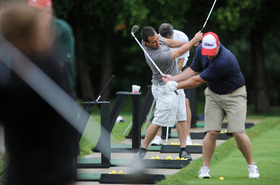Proper club selection and confidence key ingredients to curing ETS on the course

Picking the proper club is half the battle when suffering from Elevated Tee Syndrome.
Courtney Sacco | AnnArbor.com file photo
At the time I wondered - much like you probably are now - “what on earth is that?”
Don’t worry, a bowl of chicken noodle soup and a trip to the drug store aren’t necessary to cure this ailment. ETS stands for Elevated Tee Syndrome.
My friend introduced me to the term when we were playing one of the most beautiful golf courses I have ever seen at the Madeira Island Open in Portugal. The course meandered up and down a mountain with elevation changes close to 500 feet from tee to green. The layout was fairly simple and appeared to be scoring friendly: wide fairways, big greens and shorter rough.
GOLF ADVICE
Now-a-days we have range finders with elevation calculations assisting us in finding the right yardage to play. Though not allowed on the PGA Tour, using these devices has a great advantage learning the slopes and elevation changes of courses and their use is now allowed at all of the PGA’s junior golf tournaments. You might want to double check with a rules official before bringing the range finder to a local tournament, but for the most part they are allowed until you reach the highest level of competition.
What challenges us as a golfer is deciphering the "feel" to hit the shot. It may be a simple pitch down the hill, or an elevated approach Par 3, but each shot requires something different from the normal driving range rhythm. You must adjust the distance and feel how ball will react with the change in elevation. Hitting at the pin 150 yards away up a steep hill is different than zeroing in on the same distance from an elevated tee box on a Par 3.
Treetops, the Rick Smith Par 3 course in northern Michigan, leaves many golfers suffering from ETS. On No. 2, just to check the flag position you are grabbing onto your playing partner for dear life in fear of falling over the cliff. After I finished playing there for the first time, I remember having the conversation that it seemed like I hit the same club on every hole. The distances varied from 210-110 yards from hole-to-hole, but with the elevation change it all leveled out to about an 8 iron.
What makes playing a new golf course so much fun is having the opportunity to match your game to the challenges the design demands. Unless you are playing in south Florida, elevation changes will play a big part of your shot making. There are a few keys to keep in mind when playing to an elevation change so the ETS doesn't get the best of you.
- Take advantage of technology: Range finders have revolutionized the game. You won't find a tour player without one. It is accurate, reliable and a great way to test your feel against elevation change.
- Formulate a yardage: One of the most important aspects in hitting a golf shot is observing all of the current conditions and formulating a distance to hit the shot. Range finders make this easy to find the slope, but if there is wind it can complicate the matter very easily. The key is to formulate a distance factoring in elevation change so you know exactly what yardage to hit the shot.
- Stay committed to the shot: Once you have mapped out the yardage for the shot, it is not always easy to stay committed to the shot. For example, the elevated tee of the Par 3 No. 15 at Radrick Farms in Ann Arbor has a jungle immediately behind the green. Hitting from such an elevated tee - exposed to the wind and the visual intimidation - it is easy to not fully commit and end up considerably short on the approach. Make a decision and stick with it. If the shot doesn’t work out, oh well, at least you went for it and make an adjustment the next time. It’s always better to go down swinging.
Contact your local Golf Professional and have them assist you in managing your game.
Kyle Dobbs is a former professional and University of Michigan golfer. He grew up in Ann Arbor and won the individual Big Ten title for the University of Michigan men’s golf team his senior year in 1997. He can be reached at kdobbsgolf@gmail.com.



Comments
Hmm
Fri, May 3, 2013 : 5:33 p.m.
Only course around here that I have played where elevation changes may be a significant factor would be numbers one, eight, and nine at The Jackal on Mt. Brighton. I don't like #9 at all, 1 and 8 are fun though. Keep the golf articles coming I like it!
Hmm
Fri, May 3, 2013 : 7:19 p.m.
Actually I guess I forgot about Eaglecrest, there are a few holes on there that have a little bit of an elevation change but it seems like Mt. Brighton is the worst in the area from what I have seen.
Kyle Dobbs
Fri, May 3, 2013 : 5:55 p.m.
The Jackal, I'll have to check it out. Never heard of that course before.
treetowncartel
Fri, May 3, 2013 : 3:31 p.m.
You don't have to go to south Florida for a flat course, Rackham out by Detroit Zoo is pretty flat.
Kyle Dobbs
Fri, May 3, 2013 : 5:54 p.m.
Your right, most of south east MI is fairly flat. I love it up north though, its a whole new way of golfing. Hope to spend a little time up there this year and cure some "ETS".